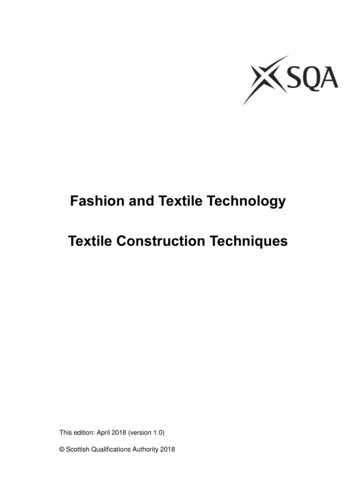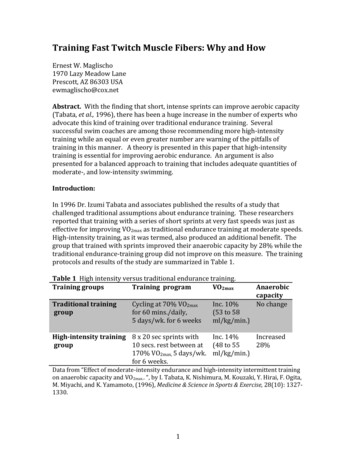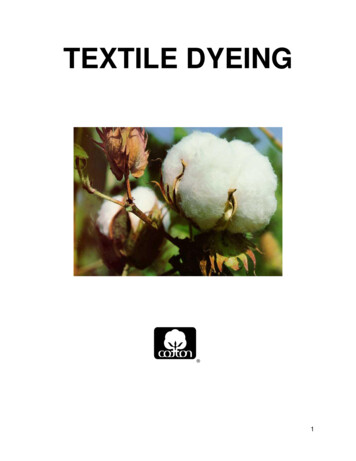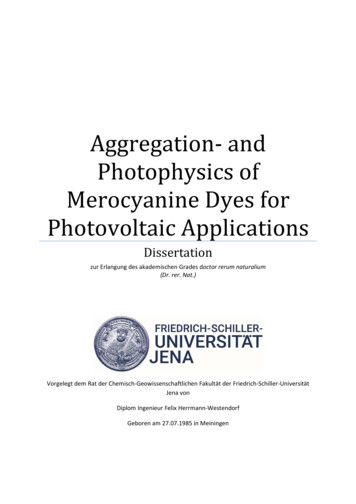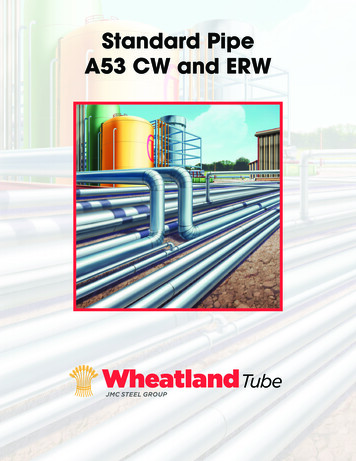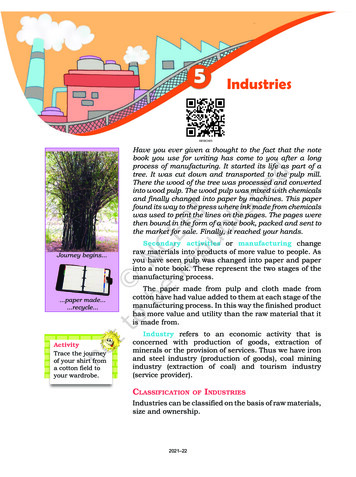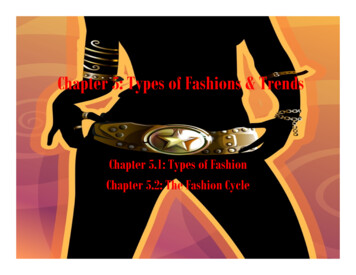
Transcription
TEXTILE FIBERS, DYES,FINISHES, AND PROCESSES
TEXTILE SERIESHoward L. Needles, EditorFABRIC FORMING SYSTEMSBy Peter Schwartz, Trever Rhodes and MansourMohamedTEXTILE IDENTIFICATION, CONSERVATION,AND PRESERVATIONBy Rosalie Rosso KingTEXTILE MARKETING MANAGEMENTBy Gordon A. Berkstresser IIITEXTILE WET PROCESSES: Vol. I. Preparation ofFibers and FabricsBy Edward S. OlsonTEXTILE FIBERS, DYES, FINISHES, AND PROCESSES: A Concise GuideBy Howard L. NeedlesAUTOMATION AND ROBOTICS IN THE TEXTILEAND APPAREL INDUSTRIESEdited by Gordon A. Berkstresser III and David R.BuchananOther TitleTEXTILE DYEING OPERATIONS: Chemistry,Equipment, Procedures, and Environmental AspectsBy S. V. Kulkarni, C.D. Blackwell, A.L. Blackard,C. W. Stackhouse and M. W. Alexander
TEXTILE FIBERS, DYES,FINISHES, AND PROCESSESA Concise GuidebyHoward L. NeedlesUniversity of California, DavisDavis, Cal ifornia
Copyright 1986 by Howard L. NeedlesNo part of this book may be reproduced in any formwithout permission in writing from the Publisher.Library of Congress Catalog Card Number: 86-5203ISBN: 0-8155-1076-4Printed in the United StatesPublished in the United States of America byNoyes PublicationsMill Road, Park Ridge, New Jersey 076561098765Library of Congress Cataloging-in-Publication DataNeedles, Howard L.Textile fibers, dyes, finishes, and processes.Bibliography: p.I ncludes index.1. Textile fibers. 2. Textile finishing. 3. Dyesand dyeing-- Textile fibers. I. Title.TS1540.N434 1986677'.02886-5203ISBN 0-8155-1076-4
PrefaceFibers from natural sources have been used for thousands of years for producingtextiles and related products. With the advent of the spinning jet in the mid19th century, fibers could be formed by forcing dissolved polymeric materialsthrough a small orifice (spinneret) into a coagulating bath . Regenerated naturaland synthetic man-made fibers have been formed by this basic spinning technique or variations thereof since then . By the turn of the 20th century, rayon,a regenerated cellulosic and the first man-made fiber of commercial importance,was in full production . By the 1920s the cellulose derivatives acetate and triacetate were introduced as fibers of commerce, and inorganic glass fibers appeared during the mid-1930s . The first synthetic fiber (nylon) chemically synthesized from basic monomeric units and based on petroleum feedstocks appeared in the late 1930s . The advent of nylon marked a new era for fiber production, and several new types of synthetic fibers, including polyester, acrylic,modacrylic, polyolefin, and vinyl fibers, appeared in the 1940s, 1950s, and1960s.In less than 40 years we have gone from a period where fibers were availableonly from natural or regenerated sources to a time where a broad spectrum offibers are available. The wide range of properties available in fibers today hasgreatly expanded the applications and areas in which fibers can be used. Evenwith such a range of properties available in fibers , each class of fiber has inherent deficiencies that require that chemical finishes or physical modifications be applied to the fiber. Also, addition of color to the fiber through dyeingor printing is necessary to meet the demand of the consumer for a wide spectrum of colors and patterns in textile products. Since 1945 a number of newtextile processes have been introduced providing unique methods to formyarns and textile substrates of widely varying structure and properties. Thisbook addresses itself to the structure and properties of textile fibers, dyes, andfinishes and the processes used in fiber, yarn, and substrate formation and indyeing and finishing of these substrates .v
VIPrefaceOwing to the growing number, types, and complexity of fibers now available foruse in consumer textiles, students or professionals in textiles, textiles and clothing, and textile science need not only a listing of fibers and fiber properties butalso a firm foundation in the relationship of fiber structure to the physical andchemical properties of fibers, as well as the consumer end-use properties thatresult in textiles made from these fibers. They also need to be acquainted withthe processes used in formation of textile fibers, yarns, and fabric substratesand in dyeing and finishing these substrates. Textbooks in consumer textilesoften stress the more aesthetic areas of textiles, whereas textbooks in textilechemistry and textile physics present a highly rigorous approach to the field.A book which lies between these two extremes would be of value to those withan intermediate understanding of the physical sciences. Thus this book discusses textile fibers, dyes, finishes, and processes using this intermediate approach, presenting in a concise manner the underlying principles of textile chemistry, physics, and technology. It should be an aid to students and professionalsin textiles, textiles and clothing, and textile science, who desire a basic knowledge of textile fibers, finishes, and processes and their related consumer enduse. The book should also serve as a sourcebook of information within the textile and apparel industries.I thank my colleagues and students who have contributed in numerous ways tothis book. I especially thank Barbara Brandon for her expert preparation of thebook for print.University of Cal ifornia, DavisMarch, 1986Howard L. Needles
ABOUT THE AUTHORHoward L. Needles is presently Professor ofTextiles and Materials Science at the University of Cal ifornia, Davis. After receiving hisdoctorate in organic chemistry from theUniversity of Missouri in 1963, he began hiscareer conducting research on wool and related model systems. His research was thenextended to include synthetic fibers and theeffect of chemical modification on the dyeing and color properties of these fibers. Hehas also continued his studies at NorthCarolina State University and at the University of Leeds, England, and is also ProgramChairman of the Cellulose, Paper and TextileDivision of the American Chemical Society.vii
ContentsI. FIBER THEORY, FORMATION, AND CHARACTERIZATION1. FIBER THEORY AND FORMATIONIntroductionFiber ClassificationFiber PropertiesPrimary PropertiesFiber Length to Width RatioFiber UniformityFiber Strength and FlexibilityFiber Extensibility and ElasticityFiber CohesivenessSecondary PropertiesMoisture Absorption and DesorptionFiber Resiliency and Abrasion ResistanceLusterResistance to Chemicals in the Environment.DensityThermal and Flammability CharacteristicsPrimary Fiber Properties from an Engin eering PerspectiveFiber Formation and MorphologyPolymer FormationFiber SpinningFiber Drawing and MorphologyBulking, Texturizing, and Staple FormationHeat-Setting Techniqu esAir Entangl ementDifferential SettingStaple FormationStructure-Property Relationsh ipsix11244.45566667888999111214171919202020
xContents2. FIBER IDENTIFICATION AND CHARACTERIZATIONFiber IdentificationMicroscopic IdentificationSolubilityHeating and Burning CharacteristicsDensity or Specific GravityStainingStructural, Physical, and Chemical CharacterizationOptical and Electron MicroscopyElemental and End-Group AnalysisInfrared SpectroscopyUltraviolet-Visible SpectroscopyNuclear Magnetic Resonance SpectroscopyX-Ray DiffractionThermal AnalysisMolecular Weight DeterminationMechanical and Tensile Property MeasurementsSpecific GravityEnvironmental PropertiesChemical PropertiesEnd-Use Property CharacterizationCharacteristics Related to Identity, Aesthetics, and ComfortCharacteristics Related to Durability and WearPhysical and Chemical Characteristics and Response of Fiber toIts Environmental 2829303131II. FIBER PROPERTIES3. CELLULOSIC FIBERSCottonStructural PropertiesPhysical PropertiesChemical PropertiesEnd-Use PropertiesFlaxStructural PropertiesPhysica I PropertiesChemical PropertiesEnd-Use PropertiesOther Natural Cellulosic FibersHempJuteRamieRayonStructural Properties and Formation of RayonViscose RayonCuprammonium RayonSaponified Cellulose Acetate3334353537394041414242424343434444444646
ContentsPhysical PropertiesChemical PropertiesEnd-Use Propertiesxi4648494. CELLULOSE ESTER FIBERSAcetate and TriacetateStructural Properties and FormationPhysical PropertiesChemical PropertiesEnd-Use Properties5151515455565. PROTEIN FIBERSWoolStructural PropertiesPhysical PropertiesChemical PropertiesEnd-Use PropertiesSilkPhysical PropertiesChemical PropertiesEnd-Use PropertiesOther Natural and Regenerated Protein FibersMohairCashmereLlama, Alpaca, and VicunaRegenerated Protein FibersProtein-Polyacrylonitrile Grah Copolymer585960616263646465666767676768686. POLYAMIDE FIBERSNylon 6 and 6,6Structural PropertiesPhysical PropertiesChemical PropertiesEnd-Use PropertiesAramid FibersStructural PropertiesPhysical PropertiesChemical PropertiesEnd-Use PropertiesOther PolyamidesQianaNylon 4Nylon 11Nylon 6,10Biconstituent . POLYESTER FIBERSPolyethylene Terephthalate8080
xiiContentsStructural PropertiesPhysical PropertiesChemical PropertiesEnd-Use PropertiesPoly-1,4-Cyclohexylenedimethylene TerephthalateOther PolyestersPoly-p-EthyleneoxybenzoateModified Terephthalate Polyesters81828383848585868. ACRYLIC FIBERSAcrylicStructural PropertiesPhysical PropertiesChemical PropertiesEnd-Use PropertiesModacrylicStructural PropertiesPhysical PropertiesChemical PropertiesEnd-Use PropertiesOther 9. POLYOLEFIN FIBERSPolyethylene and PolypropyleneStructural PropertiesPhysical PropertiesChemical PropertiesEnd-Use Properties95959596989810. VINYL FIBERSVinyonStructural PropertiesPhysical PropertiesChemical PropertiesEnd-Use PropertiesVinalStructural PropertiesPhysical PropertiesChemical PropertiesEnd-Use PropertiesVinyon-Vinal Matrix FiberSaranPolytetrafl 611. ELASTOMERIC FIBERSRubber108108
ContentsStructural PropertiesPhysical PropertiesChemical PropertiesEnd-Use PropertiesSpandexStructural PropertiesPhysical PropertiesChemical PropertiesEnd-Use PropertiesOther Elastomeric FibersAnidexNylon-Spandex Biconstituent Fiberxiii10911011011011111111311411411411411512. MINERAL AND METALLIC FIBERSGlassStructural PropertiesPhysical PropertiesChemical PropertiesEnd-Use PropertiesInorganic FibersAsbestosMetallic Fibers11611611611811911911912012013. MISCELLANEOUS e (PBI)Polyimide121121122123123III. YARN AND TEXTILE SUBSTRATE FORMATION14. YARN FORMATIONYarn FormationCotton SystemWoolen and Worsted SystemsOther Staple SystemsFilament SystemsOther Yarn-Forming SystemsOp en-End or Break SpinningFriction SpinningAir-Vorte x SpinningFa sciated SpinningSe lf-Twist SpinningCovers pun SpinningIntegrated Composite Yarn SpinningTwistJess 30
xivContents15. TEXTILE SUBSTRATE FORMATIONPreparationWindingWarping and SlashingDrawing-In and Tying-InTextile Substrate FormationWeavingShedding MechanismsFill InsertionSpecial Weaving MethodsKnittingWarp KnittingFill (Weft) KnittingTufting and Pile FormationNonwoven FormationMechanical Bonding or Entanglement of NonwovensStitching or Stitch BondingSelf BondingAdhesive BondingComposite 7148150151152152153IV. PREPARATION, DYEING, AND FINISHING PROCESSES16. PREPARATION AND DRYINGPreparationDrying15415415517. COLOR, DYES, DYEING AND PRINTINGColor TheoryDyes and Dye ClassificationDyes Containing Anionic Functional GroupsAcid DyesDirect DyesMordant DyesReactive DyesDyes Containing Cationic Groups (Basic Dyes)Dyes Requiring Chemical Reaction Before ApplicationVat DyesSulfur DyesAzoic DyesSpecial Colorant ClassesDisperse DyesSolvent DyesPigmentsNatural DyesDyeing of BlendsApplication Methods and Factors Affecting DyeingDyes Applied to Fiber 78180180181182183188
rforforforforforforforforforCell u losic FibersCellulose Ester FibersProtein FibersPolyamide FibersPolyester FibersAcrylic FibersPolyolefin FibersVinyl FibersElastomeric FibersMineral and Metallic Fibers18. FINISHES AND FINISHINGPhysical Finishes and FinishingOptical FinishesBrushing and NappingSoftening and ShearingCompactingChemical Finishes and FinishingFinishes Affecting Aesthetics, Comfort, and ServiceOptical FinishesHydrophilic and Soil Release FinishesSofteners and Abrasion Resistant FinishesStiffening and Weighting AgentsLaminating AgentsCrease Resistant and Stabilizing FinishesProtective FinishesPhoto protective Agents and AntioxidantsOil and Water RepellentsAntistatsBiologically Active FinishesFlame RetardantsFinishes Applied to Fiber ClassesFinishes for CellulosicsCrease Resistant and Auxiliary FinishesOil and Water Repellent FinishesBiologically Protective FinishesFlame Retardant FinishesFinishes for Cellulose Ester FibersFinishes for Protein FibersChemical SettingShrinkproofing and Wrinkle Resistance FinishesMothproofing TreatmentsWeighting TreatmentsFlame Retardant TreatmentsFinishes for Polyamide FibersPhotoprotective Agents and AntioxidantsAntistatic AgentsFlame Retardant 8
xviContentsFinishes for Polyester FibersPhoto protective Finishes and AntioxidantsAntistatic FinishesSoil Release FinishesAntipilling FinishesFlame Retardant FinishesOther FinishesFinishes for Acrylic FibersFinishes for Polyolefin FibersFinishes for Vinyl FibersFinishes for Elastomeric FibersFinishes for Mineral and Metallic Fibers208208208208209209209210210210210211V. TEXTILE MAINTENANCE19. TEXTILE SOILING AND SOIL REMOVALTextile SoilsDetergency and SurfactantsDetergency and Soil RemovalSurfactantsSoapAnionic SurfactantsNonionic SurfactantsCationic SurfactantsAmphoteric SurfactantsLaundering and Laundry FormulationsLaunderingLaundry FormulationBuildersAnti-Soil-Redeposition AgentsCorrosion InhibitorsFoam ModifiersElectrolytes and FillersBleaches and Fluorescent BrightenersGerm icidesPerfumeFabric 219219220APPENDIX: SUGGESTED FURTHER READINGFiber Theory, Formation, and Characterization and FiberPropertiesYarn and Textile Substrate FormationPreparation, Dyeing and Finishing Processes and TextileMaintenance221221222INDEX224223
I. Fiber Theory, Formation, andCharacterization1. Fiber Theory and FormationINTRODUCTIONThe word "textile" was originally used to define a woven fabric andthe proces ses i nvo1ved in weav i ng. Over the yea rs the term ha s ta ken onbroad connotations, including the following: (1) staple filaments andfibers for use in yarns or preparation of woven, knitted, tufted or nonwoven fabrics, (2) yarns made from natural or man-made fibers, (3) fabricsand other products made from fibers or from yarns, and (4) apparel or otherarticles fabricated from the above which retain the flexibility and drapeof the original fabrics. This broad definition will generally cover all ofthe products prod ced by the textile industry intended for intermediatestructures or final products.Textile fabrics are planar structures produced by interlacing orentangling yarns or fibers in some manner. In turn, textile yarns are continuous strands made up of textile fibers, the basic physical structures orelements which makes up textile products. Each individual fiber is made upof millions of individual long molecular chains of discrete chemical structure. The arrangement and orientation of these molecules within the individual fiber, as well as the gross cross section and shape of the fiber(morphology), will affect fiber properties, but by far the molecular structure of the long molecular chains which make up the fiber will determineits basic physical and chemical nature. Usually, the polymeric molecularchains found in fibers have a definite chemical sequence which repeatsitself along the length of the molecule. The total number of units whichrepeat themselves in a chain (n) varies from a few units to several hundredand is referred to as the degree of polymerization (DP) for moleculeswithin that fiber.
2Textile Fibers, Dyes, Finishes, and ProcessesFIBERCLASSIFICATION LISYNTHETICREGENERATEDIIASBESTOSjIIIIIRAYON CELLULOSE PROTEINS GLASS RUBBERESTERSWOOL MOHAIRCOTTONFigure 1-1.FLAXSILKOTHERClassification of natural and man-made fibers.FIBER CLASSIFICATIONTextile fibers are normally broken down into two main classes, naturaland man-made fibers. All fibers which come from natural sources (animals,plants, etc.) and do not require fiber formation or reformation are classedas natural fibers. Natural fibers include the protein fibers such as wooland silk, the cellulose fibers such as cotton and linen, and the mineralfiber asbestos. Man-made fibers are fibers in which either the basic chemical units have been formed by chemical synthesis followed by fiber formation or the polymers from natural sources have been dissolved and regenerated after passage through a spinneret to form fibers. Those fibers madeby chemical synthesis are often called synthetic fibers, while fibers regenerated from natural polymer sources are called regenerated fibers ornatural polymer fibers. In other words, all synthetic fibers and regener-
Fiber Theorv and Formation3ated fibers are man-made fibers, since man is involved in the actual fiberformation process. In contrast, fibers from natural sources are providedby nature in ready-made form.The synthetic man-made fibers include the polyamides (nylon), polyesters, acrylics, polyolefins, vinyls, and elastomeric fibers, while theregenerated fibers include rayon, the cellulose acetates, the regeneratedproteins, glass and rubber fibers. Figure 1-1 shows a classification chartfor the major fibers.Another method of classifying fibers would be according to chemicalstructure without regard of the origin of the fiber and its starting materials. In this manner all fibers of similar chemical structure would beclassed together. The natural man-made fiber classification given inFigure 1-1 does this to a certain extent. In this way, all fibers havingthe basic cellulosic unit in their structures would be grouped togetherrather than separated into natural and man-made fibers. This book essentially presents the fibers in groups of similar basic chemical structure,with two exceptions. In one case the elastomeric fibers have been groupedtogether due to their exceptional physical property, high extensibility andrecovery. In the other case, new fibers which do not properly "fit" intoanyone category have been placed in a separate chapter. An outl ine forthe arrangement for fibers by chemical class as presented in this sourcebook follows:Cellulosic FibersCottonFlaxOther natural cellulosicfibersRayonCellulosic Ester FibersAcetateTri aceta teProtein (Natural Polyamide)FibersWoolSilkOther natural and regenerated protein fibersPolyamide (Nylon) FibersNylon 6 and 6,6Arami dOther nylon fibersPolyester FibersPolyethylene terephthalatePoly-l,4-cyclohexylenedimethylene terephthalateOther polyester fibersAcrylic and Modacrylic FibersAcrylicModacryl icOther acryl i cs
4Textile Fibers, DVes, Finishes, and ProcessesPolyolefin FibersPolyethylenePolypropyl eneVi nyl Fi bersVinyonVinalVinyon-vinal matrixSaranPolytetrafluoroethyleneElastomeric FibersRubberSpandexOther elastomeric fibersMineral and Metallic FibersGl assInorganicAsbestosMetallicMiscellaneous FibersNovaloidCarbonPoly( -phenylenediben-zimidazole)PolyimideFIBER PROPERTIESThere are several primary properties necessary for a polymeric material to make an adequate fiber: (1) fiber length to width ratio, (2) fiberuniformity, (3) fiber strength and flexibility, (4) fiber extensibility andelasticity, and (5) fiber cohesiveness.Certain other fiber properties increase its value and desirability inits intended end-use but are not necessary properties essential to make afiber. Such secondary properties include moisture absorption characteristics, fiber resiliency, abrasion resistance, density, luster, chemicalresistance, thermal characteristics, and flammability. A more detaileddescription of both primary and secondary properties follows.Primary PropertiesFiber Length to Width Ratio: Fibrous materials must have sufficientlength so that they can be made into twisted yarns. In addition, the widthof the fiber (the diameter of the cross section) must be much less than theoverall length of the fiber, and usually the fiber diameter should be 1/100of the length of the fiber. The fiber may be "infinitely" long, as foundwith continuous filament fibers, or as short as 0.5 inches (1.3 em), asfound in staple fibers. Most natural fibers are staple fibers, whereasman-made fibers come in either staple or filament form depending on processing prior to yarn formation.
Fiber Theory and FormationFiber Uniformity:5Fibers suitable for processing into yarns and fab-rics must be fairly uniform in shape and size.Without sufficient uniform-ity of dimensions and properties in a given set of fibers to be twistedinto yarn.the actualformationofthe yarn may beimpossible or theresulting yarn may be weak, rough, and irregular in size and shape and unsuitable for textile usage.Natural fibers must be sorted and graded toassure fiber uniformity, whereas synthetic fibers may be "tailored" by cutt i ng into appropri a te un i form 1engths to gi ve a proper degree of fi beruniformity.Fiber Strength and Flexibil ity:A fiber or yarn made from the fibermust possess sufficient strength to be processed into a textile fabric orother textile article.Following fabrication into a textile article. theresul ting textile must have sufficient strength to provide adequate durability during end-use.gramsMany experts consider a single fiber strength of 5per denier to be necessary for a fiber suitable in most textileapplications, although certain fibers with strengths as low as 1.0 gram perdenier have been found suitable for some applications.The strength of a single fiber is called the tenacity, defined as theforce per unit linear density necessary to break a known unit of thatfiber.The breaking tenacity of a fiber may be expressed in grams perdenier (g/d) or grams per tex (g/tex).1 inear densityBoth denier and tex are units of(mass per unit of fiberlength) and are defined asthenumber of grams of fiber measuring 9000 meters and 1000 meters, respectively.As a result, the denier of a fiber or yarn will always be 9 times thetex of the same fiber.Since tenacities of fibers or yarns are obtained bydividing the force by denier or tex, the tenacity of a fiber in grams perdenier will be 1/9 that of the fiber tenacity in grams per tex.As a result of the adaption of the Internationalref erredtoasS I.thea ppropri ate1engthun itforSystem of Units.brea kingtenac itybecomes kilometer (km) of breaking length or Newtons per tex (N/tex) andwill be equivalent in value to g/tex.The strength of a fiber. yarn, or fabric can be expressed in terms offorce per unit area, and when expressed in this way the term is tensilestrength.The most common unit used in the past for tensile strength hasbeen pounds force per square inch or grams force per square centimeter.In51 units, the pounds force per square inch x 6.895 will become kilopascals(kPa) and grams force per square centimeter x 9.807 will become megapascals(MPa) .
6Textile Fibers, Dyes, Finishes, and ProcessesA fiber must be sufficiently fle xible to go through repeated bendingwithout significant strength deterioration or breakage of the fiber. Without adequate flexibility, it would be impossible to convert fibers intoyarns and fabrics, since fle xing and bending of the individual fibers is anecessary part of this conversion. In addition, individual fibers in ate xtile will be subjected to considerable bending and flexing during enduse.Fiber Extensibility and Elasticity : An individual fiber must be ableto undergo slight extensions in length (less than 5%) without breakage ofthe fiber. At the same time the fiber must be able to almost completelyrecover following slight fiber deformation. In other words, the extensiondeformation of the fiber must be nearly elastic. These properties areimportant because the individual fibers in textiles are often subjected tosudden stresses, and the textile must be able to give and recover withoutsignificant overall deformation of the textile.Fiber Cohesiveness: Fibers must be capable of adhering to one anotherwhen spun into a yarn. The cohesiveness of the fiber may be due to theshape and contour of the individual fiber s or the nature of the surface ofthe fibers. In addition, long-filament fibers by virtue of their lengthcan be twisted together to give stabil ity without true cohesion betweenfibers . Often the term "spinning qual ity" is used to state the overallattra ctiveness of fibers for one another.Secondary PropertiesMoisture Absorption and Desorption: Most fibers tend to absorb moistu re (wa ter va por) when in contact with the atmos phere. The amoun t ofwater absorbed by the textile fiber will depend on the chemical and physical structure and properties of the fiber, as well as the temperature andhumidity of the surroundings. The percentage absorption of water vapor bya fiber is often expressed as its moi sture regain. The regain is determined by weighing a dry fiber, then placing it in a room set to standardtemperature and humidity (21 1 C and 65% relative humidity [RH] arecommonly used). From these measurements, the percentage moisture regain ofthe fiber is determined:00Conditioned weight - Dry weight x 100%Percentage regain - -- - - Dry wei ght
Fiber Theory and Formation7Percentage moisture content of a fiber is the percentage of the totalweight of the fiber which is due to the moisture present, and is obtainedfrom the following formula:Percentage moisture contentConditioned weight - Dry weight x 100%Conditioned weightThe percentage moisture content will always be the smaller of the twovalues.Fibers vary greatly in their regain, with hydrophobic (water-repelling) fibers having regains near zero and hydrophilic (water-seeking)fibers 1ike cotton, rayon, and wool having regains as high as 15% at 21 Cand 65% RH. The ability of fibers to absorb high regains of water affectsthe basic properties of the fiber in end-use. Absorbent fibers are able toabsorb large amounts of water before they feel wet, an important factorwhere absorption of perspiration is necessary. Fibers with high regainswill be easier to process, finish, and dye in aqueous solutions, but willdry more slowly. The low regain found for many man-made fibers makes themquick drying, a distinct advantage in certain appl ications. Fibers withhigh regains are often desirable because they provide a "breathable" fabricwhich can conduct moisture from the body to the outside atmosphere readily,due to their favorable moisture absorption-desorption properties. The tensile properties of fibers as well as their dimensional properties are knownto be affected by moisture.Fiber Resiliency and Abrasion Resistance: The ability of a fiber toabsorb shock and recover from deformation and to be generally resistant toabrasion forces is important to its end-use and wear characteristics. Inconsumer use, fibers in fabrics are often placed under stress through compression, bending, and twisting (torsion) forces under a variety of temperature and humidity conditions. If the fibers within the fabric possessgood elastic recovery properties from such deformative actions, the fiberhas good resiliency and better overall appearance in end-use. For example,cotton and wool show poor wrinkle recovery under hot moist conditions,whereas polyester exhibits good recovery from deformation as a result ofits high resiliency. Resistance of a fiber to damage when mobile forces orstresses come in contact with fiber structures is referred to as abrasionresistance. If a fiber is able to effectively absorb and dissipate theseforces without damage, the fiber will show good abrasion resistance. Thetoughness and hardness of the fiber is related to its chemical and physicalstructure and morphology of the fiber and will influence the abrasion ofthe fiber. A rigid, brittle fiber such as glass, which is unable to dissi-
8Textile Fibers, Dyes, Finishes, and Processespate the forces of abrasive action, results in fiber damage and breakage,whereas a tough but more plastic fiber such as polyester shows better resistance to abrasion forces.Finishes can affect fiber properties in-cluding resiliency and abrasion resistance.Luster :Luster refers to the degree of light that is reflected fromthe surface of a fiber or the degree of gloss or sheen that the fiber possesses.The inherent chemical and physicalstructure and shape of thefiber can affect the relative luster of the fiber.With natural fibers theluster of the fiber is dependent on the morphologicalform that naturegives the fiber, although the relative luster can be changed by chemicaland/or physical treatment of the fiber as found in processes such as mercerization of cotton.Man-made fibers can vary in luster from bright todull depending on the amount of delusterant added to the fiber.Oeluster-ants such as titanium dioxide tend to scatter and absorb 1ight, therebymaking the fiber appear duller.The desirability of luster for a givenfiber application will vary and is often dependent on the intended end-useof the fiber in a fabric or garment form and on current fashion trends.Resistance to Chemicals in the Environment:A textile fiber to beuseful must have reasonable resistance to chemicals it comes in contactwith in its environment during use and maintenance.It should have resis-tance to oxidation by oxygen and other gases in the air, particularly i
book addresses itself to the structure and properties of textile fibers, dyes, and finishes and the processes used in fiber, yarn, and substrate formation and in dyeing and finishing of these

